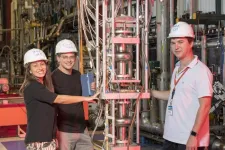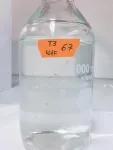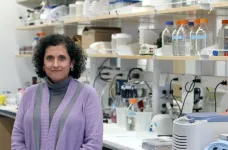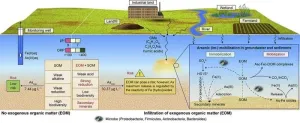(Press-News.org) Scientists working on the Dark SRF experiment at the U.S. Department of Energy’s Fermi National Accelerator Laboratory have demonstrated unprecedented sensitivity in an experimental setup used to search for theorized particles called dark photons.
Researchers trapped ordinary, massless photons in devices called superconducting radio frequency cavities to look for the transition of those photons into their hypothesized dark sector counterparts. The experiment has put the world’s best constraint on the dark photon existence in a specific mass range, as recently published in Physical Review Letters.
“The dark photon is a copy similar to the photon we know and love, but with a few variations,” said Roni Harnik, a researcher at the Fermilab-hosted Superconducting Quantum Materials and Systems Center and co-author of this study.
Light that allows us to see the ordinary matter in our world is made of particles called photons. But ordinary matter only accounts for a small fraction of all matter. Our universe is filled with an unknown substance called dark matter, which comprises 85% of all matter. The Standard Model that describes the known particles and forces is incomplete.
In theorists’ simplest version, one undiscovered type of dark matter particle could account for all the dark matter in the universe. But many scientists suspect that the dark sector in the universe has many different particles and forces; some of them might have hidden interactions with ordinary matter particles and forces.
Just as the electron has copies that differ in some ways, including the muon and tau, the dark photon would be different from the regular photon and would have mass. Theoretically, once produced, photons and dark photons could transform into each other at a specific rate set by the dark photon’s properties.
Innovative use of SRF cavities
To look for dark photons, researchers perform a type of experiment called a light-shining-through-wall experiment. This approach uses two hollow, metallic cavities to detect the transformation of an ordinary photon into a dark matter photon. Scientists store ordinary photons in one cavity while leaving the other cavity empty. They then look for the emergence of photons in the empty cavity.
Fermilab researchers in the SQMS Center have years of expertise working with SRF cavities, which are used primarily in particle accelerators. SQMS Center researchers have now employed SRF cavities for other purposes, such as quantum computing and dark matter searches, due to their ability to store and harness electromagnetic energy with high efficiency.
“We were looking for other applications with superconducting radio frequency cavities, and I learned about these experiments where they use two copper cavities side-by-side to test for light shining through the wall,” said Alexander Romanenko, SQMS Center quantum technology thrust leader. “It was immediately clear to me that we could demonstrate greater sensitivity with SRF cavities than cavities used in previous experiments.”
This experiment marks the first demonstration of using SRF cavities to perform a light-shining-through-wall experiment.
The SRF cavities used by Romanenko and his collaborators are hollow chunks of niobium. When cooled to ultralow temperature, these cavities store photons, or packets of electromagnetic energy, very well. For the Dark SRF experiment, scientists cooled the SRF cavities in a bath of liquid helium to around 2 K, close to absolute zero.
At this temperature, electromagnetic energy flows effortlessly through niobium, which makes these cavities efficient at storing photons.
“We have been developing various schemes trying to handle the new opportunities and challenges brought in by this ultra-high-quality superconducting cavities for this light-shining-through-wall experiment,” said study co-author Zhen Liu, an SQMS Center physics and sensing team member from the University of Minnesota.
Researchers now can use SRF cavities with different resonance frequencies to cover various parts of the potential mass range for dark photons. This is because the peak sensitivity on the mass of the dark photon is directly related to the frequency of the regular photons stored in one of the SRF cavities.
“The team has done many follow-ups and cross-checks of the experiment,” said Liu, who worked on the data analysis and the verification design. “SRF cavities open many new search possibilities. The fact we covered new parameter regions for the dark photon’s mass shows their successfulness, competitiveness and great promise for the future.”
“The Dark SRF experiment has paved the way for a new class of experiments under exploration at the SQMS Center, where these very high Q cavities are employed as extremely sensitive detectors.” said Anna Grassellino, director of the SQMS Center and co-PI of the experiment. “From dark matter to gravitational waves searches, to fundamental tests of quantum mechanics, these world’s-highest-efficiency cavities will help us uncover hints of new physics.”
Fermi National Accelerator Laboratory is supported by the Office of Science of the U.S. Department of Energy. The Office of Science is the single largest supporter of basic research in the physical sciences in the United States and is working to address some of the most pressing challenges of our time. For more information, please visit science.energy.gov.
END
Dark SRF experiment at Fermilab demonstrates ultra-sensitivity for dark photon searches
2023-07-21
ELSE PRESS RELEASES FROM THIS DATE:
Extracellular vesicles could aid spread of scleroderma-caused fibrosis throughout body
2023-07-21
Extracellular vesicles, responsible for cell-to-cell communication, might be a driver of fibrosis in systemic sclerosis, according to a recent paper in Arthritis and Rheumatology.
Characterized by stiff and hardening tissue known as fibrosis, systemic sclerosis – also known as scleroderma – can affect the skin as well as other organs. Most research has focused on the pathology and starting point of fibrosis, but researchers at the Medical University of South Carolina are focusing ...
Ricardo Valerdi named Head of Systems and Industrial Engineering at the University of Arizona
2023-07-21
Ricardo Valerdi was selected as head of the Department of Systems and Industrial Engineering after a national search that yielded a highly competitive pool of candidates after serving as interim head for the 2022-2023 academic year.
“When I joined SIE 12 years ago, it looked very different,” said Valerdi. “Today we have a new generation of talented and ambitious faculty who are impacting our society’s Grand Challenges in manufacturing, transportation, aerospace ...
BioIVT to discuss its pivotal role in liquid biopsy research at the AACC Annual Scientific Meeting and Clinical Lab Expo
2023-07-21
BioIVT, a global research partner and biospecimen solutions provider for drug and diagnostic development, today announced that it will highlight the integral role it is playing in liquid biopsy research at the American Association for Clinical Chemistry (AACC) Annual Scientific Meeting and Clinical Lab Expo. This conference will be held from July 23-27 at the Anaheim Convention Center in Anaheim, CA.
“Liquid biopsy research can revolutionize the way we detect, diagnose, and treat diseases. However, several issues need to be resolved before it can reach its full potential. They include adopting ...
Father’s psychiatric diagnosis increases risk of preterm birth, study reports
2023-07-21
Babies are more likely to be born prematurely when either their father or mother has had a psychiatric diagnosis, according to a study conducted by researchers at the Icahn School of Medicine at Mount Sinai and the Karolinska Institutet and published July 20 in the open access journal PLOS Medicine.
The research shows, for the first time, that the risk of preterm birth is higher in infants whose father or mother has a psychiatric diagnosis than in those whose parents do not, and higher still when both parents have such diagnoses.
Preterm ...
Multi-society statement on US Supreme Court ruling on students for fair admissions
2023-07-21
ROCKVILLE, MD—JULY 19, 2023 – As organizations representing a wide range of scientific, engineering, and mathematical disciplines, we will not be deterred by the U.S. Supreme Court ruling on race considerations in college and university admissions.
America’s inherent strength and economic competitiveness among nations is its domestic and international talent across every race, ethnicity, gender, and geography. To meet current and emerging job demands and retain our research and development leadership globally, we must broaden who participates in science, technology, engineering, mathematics, and medicine. Doing so will improve lives, advance our nation’s living standards, ...
Harnessing machine learning for early cancer detection in primary care
2023-07-21
“[Machine learning] has the potential to transform early cancer detection in primary care [...]”
BUFFALO, NY- July 21, 2023 – A new editorial paper was published in Oncoscience (Volume 10) on June 9, 2023, entitled, “Transforming early cancer detection in primary care: harnessing the power of machine learning.”
Cancer remains a significant global health burden, and early detection plays a crucial role in improving patient outcomes. Primary care settings serve as frontline gatekeepers, providing an opportunity for early detection through symptom assessment and ...
New study uncovers potential risk of arsenic release from sediment under organic matter influence
2023-07-21
Researchers from the Chinese Research Academy of Environmental Sciences have conducted a study to assess the impact of environmental factors and microbial communities on the mobilization of arsenic (As). The findings, published in Volume 15 of the journal Environmental Science and Ecotechnology, reveal important insights into the biogeochemical processes involved in As release. The study focused on processes such as desorption, reduction, complexation, and co-precipitation that affect the As behaviour in the environment. The interaction ...
$20 million awarded to lead next century of heart disease and stroke scientific research
2023-07-21
DALLAS, July 21, 2023 — More than 100 scientists from across the U.S. are receiving special grants to support their research work in finding innovative solutions to fight heart disease and stroke. The grants, totaling $20 million, are part of the Second Century of Science Initiative of the American Heart Association, the world’s leading voluntary organization dedicated to a world of longer, healthier lives. The financial awards are announced as the Association, the largest non-government supporter of heart and brain health research in the U.S., prepares to celebrate ...
BESSY II: Surface analysis of catalyst particles in aqueous solutions
2023-07-21
Green hydrogen can be produced directly in a photoelectrochemical cell, splitting water with solar energy. However, this requires the development of super-efficient photoelectrodes that need to combine many talents at the same time: They must be excellent at converting sunlight into electricity, remain stable in acidic or basic water, act as catalysts to promote the splitting of water into hydrogen and oxygen, and be cheap, abundant and non-toxic. The large material class of metal oxides comes into question. However, it is difficult to find out what really happens at the interfaces ...
Study: How mother and infant sleep patterns interact during the first two years of life
2023-07-21
URBANA, Ill. — New mothers can expect sleep deprivation in the first few years of baby’s life. But too little sleep can take a toll on the health of both mother and child. A new study from the University of Illinois Urbana-Champaign looks at maternal and infant sleep patterns, identifying predictors and providing recommendations for instilling healthy habits.
“The first two years is a really critical period where a lot of development is going on, and sleep is important for health. We wanted to look at the association of mother and infant sleep and whether it changes over time,” said Tianying ...










